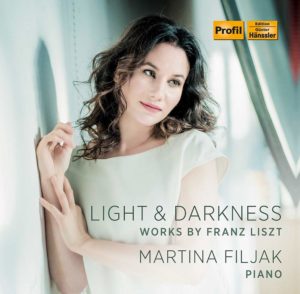The Croatian pianist Martina Filjak first came to my attention when she won first prize in the 2009 Cleveland International Piano Competition, which led to a highly acclaimed New York debut recital at Zankel Hall in Carnegie Hall. She launched the Naxos label’s complete Soler keyboard sonata cycle, and in 2017 released a solo CD that featured commanding performances of the first sonatas by both Scriabin and Schumann. Filjak now turns her attention to Liszt, where she puts her considerable technical and coloristic resources to good use.
In the opening selection, Miserere after Palestrina, Filjak projects the slow, declamatory pages with a full-bodied and singing tone, and avoids any trace of notey clatter in the long stretches of tremolos and sweeping arpeggios that follow. She finds plenty of opportunity to display breadth and nuance throughout the B minor Ballade, although the central section’s broken right-hand octave passages come off relatively glib next to the agitated urgency of Claudio Arrau’s great 1969 recording. Interestingly, at the work’s “grandioso” climax (14:32), Filjak opts for Liszt’s repeated-chord ossia instead of the more effective upward scales set out in the original text.
Her spacious and robust conceptions of the two St. Francis Legends contrast to Joseph Moog’s slicker, virtuoso-oriented recent versions, and for the better. Although generous rubatos and frequent sectional ritards can potentially drain the life force out of the arguably overlong Bénédiction de Dieu dans la solitude, Filjak’s remarkable sustaining power and ravishing pedal effects justify her unusually slow tempos (the performance clocks in a little past the 20-minute mark for a piece that normally lasts 15 to 17 minutes).
In the Liszt/Donizetti Lucia di Lammermoor Paraphrase the first appearance of the Sextet’s main theme sounds surprisingly literal and expressionless (studio nerves?), yet Filjak loosens up as the music unfolds and the notes multiply tenfold. This familiar piece is followed by a Lisztian rarity, his paraphrase based on the Grande Marche d’Abdul Médjid Khan, composed by Gaetano Donizetti’s younger, less-famous brother Giuseppe. Filjak matches Leslie Howard’s incisive rhythm in the introductory pages, and takes Liszt’s “animato” directive to heart with her exuberantly forthright “Tempo di Marcia” section, in contrast to Gülsin Onay’s altogether safer interpretation on Sono Luminus.
And what an inspired idea to close out her Liszt recital with Arvo Pärt’s Für Alina (the shorter of his pieces with that title), going from maximal to minimal, so to speak. The opening C-natural bass octave envelops the room as Filjak gives each gesture in the sparse musical line its own flavor, helped by Profil’s ample sonics. All told, a release well worth investigating.
































